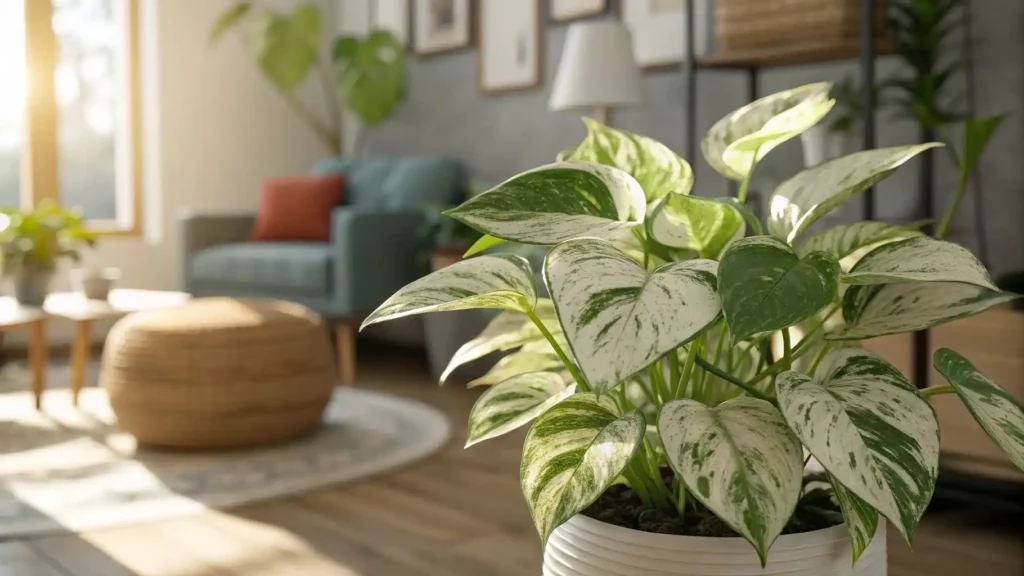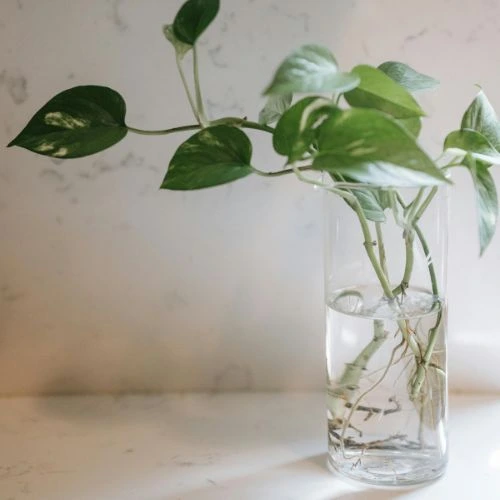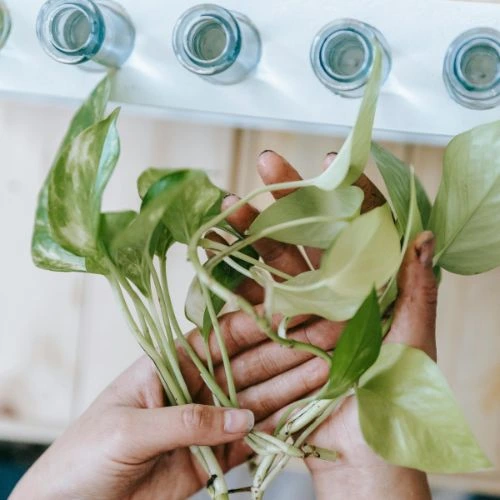Looking to elevate your indoor garden with a stunning, low-maintenance plant? The Marble Queen Pothos is a perfect option. Known for its eye-catching marbled leaves and easy care requirements, this plant is a favorite among both beginners and seasoned plant lovers. Whether you want to freshen up your living space or add a touch of elegance, this resilient beauty can thrive with minimal effort.
In this guide, we’ll explore everything you need to know about Marble Queen Pothos care—from ideal lighting and watering tips to fertilization, repotting, and troubleshooting common issues. Plus, you’ll discover how to propagate this plant for free! Get ready to enjoy lush, vibrant foliage that turns heads and enhances your home.
In This Article
| Common Name | Marble Queen Pothos |
| Botanical Name | Epipremnum aureum ‘Marble Queen’ |
| Family | Araceae |
| Plant Type | Perennial Vine |
| Mature Size | 6-10 feet long indoors |
| Bloom Time | Rarely blooms indoors |
| Toxicity | Toxic to pets |
| Sun Exposure | Bright, indirect light |
| Soil Type | Well-draining potting mix |
| Soil pH | 6.0–6.5 (slightly acidic) |
| Flower Color | White (rare indoors) |
| Hardiness Zones | 10-12 (outdoors) |
| Native Area | Southeast Asia and Pacific Islands |

Understanding Marble Queen Pothos
The Marble Queen Pothos is a stunning, low-maintenance houseplant perfect for beginners and plant enthusiasts alike. Its striking variegated leaves, with splashes of creamy white and green, add a touch of elegance to any indoor space. Here is what makes this plant so special :
Key Features of the Marble Queen Pothos:
- Unique Appearance: The white and green marbled leaves create a sophisticated look.
- Air Purifying: Known to filter toxins from the air, making it a healthy choice for homes.
- Adaptable Growth: Thrives as a hanging plant, trailing from shelves, or climbing trellises.
- Low Maintenance: Tolerates a variety of conditions, making it easy to care for.
Why Choose a Marble Queen Pothos?
- Beginner-Friendly: Ideal for those new to indoor gardening.
- Versatile Decor: Fits seamlessly into modern, minimalist, or rustic interiors.
- Hardy Nature: Can survive occasional neglect, such as missed watering.
- Affordable Beauty: Adds style to your home without breaking the bank.
The Marble Queen Pothos is native to tropical regions like Southeast Asia, where it grows as a climbing vine in the wild. When cared for properly, this plant can thrive indoors, bringing natural beauty and fresh air to your living space.
Marble Queen Pothos Care: Ideal Lighting
Getting the right lighting is crucial for proper Marble Queen Pothos care. This plant prefers bright, indirect sunlight, which mimics its natural habitat under tropical forest canopies.
Optimal Lighting Conditions:
- Bright, Indirect Light: Keep the plant close to a window where it gets filtered sunlight. An east- or south-facing window will be great.
- Avoid Direct Sunlight: Direct rays can scorch the leaves, causing brown spots or faded colors.
- Tolerates Low Light: While it can adapt to lower light, the plant’s variegation may fade over time.
Tips for Indoor Placement:
- Position the plant about 3-5 feet away from a bright window.
- Use sheer curtains to diffuse strong sunlight.
- Rotate your plant occasionally to ensure even light distribution and thus even growth.
Signs Your Plant Needs More or Less Light:
- Too Much Light: Yellowing or crispy edges on leaves.
- Too Little Light: Leggy growth and reduced variegation.
If natural light is limited, consider using a grow light to provide consistent brightness. A full-spectrum LED grow light is an excellent option to supplement light in darker areas.
Proper lighting ensures your Marble Queen Pothos maintains its vibrant colors and healthy growth, making it a standout in your indoor garden.
Marble Queen Pothos Care: Choosing the Right Soil
The right soil is key to successful Marble Queen Pothos care. This plant thrives in a well-draining, nutrient-rich potting mix.
Best Soil Mix for Marble Queen Pothos:
- Key Ingredients: Combine peat moss, perlite, and standard potting soil.
- Well-Draining: The best way to prevent waterlogging, which can cause root rot.
- Nutrient-Rich: Ensures healthy growth and vibrant leaves.
Quick Tips:
- Avoid heavy garden soils as it retains too much moisture.
- If needed, add perlite or sand to improve drainage.
- Check that the soil remains slightly moist but never soggy.
Using the ideal soil will keep your Marble Queen Pothos healthy and thriving.
Watering Marble Queen Pothos
Watering is a crucial part of Marble Queen Pothos care, and finding the right balance is key. Underwatering may cause droopy leaves while overwatering can lead to root rot.
Watering Guidelines:
- How Often: Water when the top 1-2 inches of soil feel dry to the touch.
- Technique: Use room-temperature water and pour until excess drains out of the bottom.
- Avoid Waterlogging: Empty saucers to prevent standing water.
Signs of Improper Watering:
- Overwatering: Yellow leaves or mushy stems.
- Underwatering: Wilting or crispy brown edges.
Quick Tip: If you’re unsure whether it’s an overwatering or an underwatering issue, rather err on the side of slightly underwatering. This resilient plant bounces back better from dryness than soggy roots.
Consistent watering practices will help your Marble Queen Pothos grow lush and vibrant.
Fertilizing Tips
Proper fertilization plays an important role in effective Marble Queen Pothos care. While this plant isn’t a heavy feeder, the right nutrients can boost its growth and keep its variegation vibrant.
When to Fertilize:
- Feed your Marble Queen Pothos during its active growing seasons: spring and summer.
- Fertilize once a month for optimal results.
- Avoid fertilizing when growth slows in fall and winter.
Best Fertilizers for Marble Queen Pothos:
- Liquid Fertilizers: A balanced 10-10-10 or 20-20-20 liquid fertilizer diluted to half strength works best.
- Slow-Release Fertilizers: These provide consistent nutrients over several months.
- Organic Options: Compost tea or fish emulsion can be gentle yet effective.
Application Tips:
- In order to prevent root burn, water the plant before fertilizing.
- To avoid overfeeding, always follow the package instructions.
- Monitor for signs of over-fertilization, such as brown leaf tips or salt build-up in the soil.
Quick DIY Option:
Make a natural fertilizer using banana peels soaked in water for a few days, then use it as a nutrient-rich feed.
Fertilizing regularly, but not excessively, will ensure your Marble Queen Pothos stays healthy and lush throughout the year.



Repotting Guidelines
Repotting is an essential aspect of Marble Queen Pothos care, ensuring the plant has enough space to grow and thrive.
When to Repot:
- Repot every 1-2 years, or when you notice one or more of the symptoms below:
- Roots growing out of the drainage holes.
- After watering, The plant dries out too quickly.
- Stunted growth or overcrowded roots.
Steps to Repot Your Marble Queen Pothos:
- Choose the Right Pot: Select a pot 1-2 inches larger in diameter than the current one. Ensure it has drainage holes.
- Prepare Fresh Soil: Use a well-draining potting mix tailored for Marble Queen Pothos.
- Remove the Plant: Gently loosen the plant from its pot, taking care not to damage the roots.
- Trim the Roots: Prune any mushy or overly long roots to encourage healthy growth.
- Replant and Water: Place the plant in the new pot, fill with fresh soil, and water thoroughly.
Repotting Tips:
- Repot during spring or summer for minimal stress on the plant.
- Avoid pots that are too large, as excess soil can retain water and cause root rot.
- Use gloves to handle the plant, as its sap can be mildly irritating to the skin.
Regular repotting keeps your Marble Queen Pothos vibrant, encouraging robust growth and lush, variegated foliage.
Common Problems and Solutions
Even with the best Marble Queen Pothos care, occasional issues can arise. Understanding common problems and how to address them will keep your plant thriving.
Yellowing Leaves:
- Cause: Overwatering, poor drainage, or low light.
- Solution: Check the soil’s moisture level and adjust watering frequency. Ensure the pot has proper drainage and place the plant in brighter, indirect light.
Brown Tips or Edges:
- Cause: Low humidity, underwatering, or excess fertilizer.
- Solution: Increase humidity using a pebble tray or humidifier, water more consistently, and reduce fertilizer application.
Leggy Growth:
- Cause: Insufficient light.
- Solution: Move the plant to a brighter location or use a grow light.
Pest Infestations:
- Common Pests: Spider mites, mealybugs, and scale insects.
- Solution:
- Wipe leaves with a damp cloth.
- Use insecticidal soap or neem oil.
- Isolate the plant to prevent spreading.
Root Rot:
- Cause: Overwatering or poor drainage.
- Solution: Trim away rotted roots and repot the plant in fresh, well-draining soil.
Quick action and proper adjustments can resolve most issues, ensuring your Marble Queen Pothos remains lush and healthy.
Propagation Made Easy
Propagating your Marble Queen Pothos is a fun and cost-effective way to expand your plant collection. The process is simple, and even beginners can succeed.
Why Propagate?
- Create new plants for free.
- Share cuttings with friends or family.
- Keep your main plant manageable by pruning overgrown stems.
Steps to Propagate Marble Queen Pothos:
- Take Cuttings:
- Use clean scissors to cut 4-6 inch sections of healthy stems.
- Ensure each cutting has at least two nodes (small bumps where leaves or roots grow).
- Choose a Method:
- Water Propagation:
- Place cuttings in a jar of clean water, ensuring nodes are submerged.
- Change the water every 5-7 days.
- Roots should appear within 2-4 weeks.
- Soil Propagation:
- Treat the cut ends with rooting hormone before planting them in well-moistened soil.
- To maintain a maximum level of humidity, cover with a plastic bag.
- Water Propagation:
- Transplant: Once roots are 2-3 inches long, transfer the cuttings to a pot with well-draining soil.
Propagation not only enhances your Marble Queen Pothos care routine but also lets you enjoy the satisfaction of growing new plants from cuttings.
FAQs
Can Marble Queen Pothos thrive in low light?
Yes, it can survive in low light, but its variegation may fade. For vibrant foliage, place it in bright, indirect light.
What type of soil is best for Marble Queen Pothos?
A well-draining potting mix with peat moss and perlite is ideal. Avoid heavy soil as it retains too much moisture.
How do I fix yellowing leaves?
Yellow leaves often indicate overwatering or poor drainage. Adjust your watering schedule and be sure to check for root rot.
Is Marble Queen Pothos toxic to pets?
Yes, it is toxic to pets if ingested, causing irritation or discomfort so be sure to keep it out of their reach.
How can I make my Marble Queen Pothos grow faster?
Provide optimal care: bright, indirect light, consistent watering, regular fertilization in growing seasons, and repotting when necessary.
Conclusion
Caring for a Marble Queen Pothos is a rewarding experience. With its stunning variegation and adaptable nature, it’s no wonder this plant is a favorite for indoor gardeners. By following the tips in this guide—providing the right light, watering appropriately, and addressing common problems—you’ll keep your Marble Queen Pothos thriving for years to come.
Ready to grow your indoor gardening skills even further? Subscribe to our newsletter for more expert tips, plant care guides, and exclusive insights to help you flourish in your plant journey!

